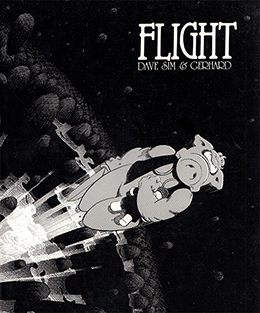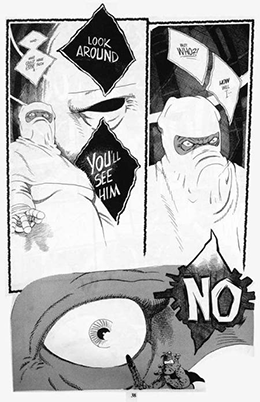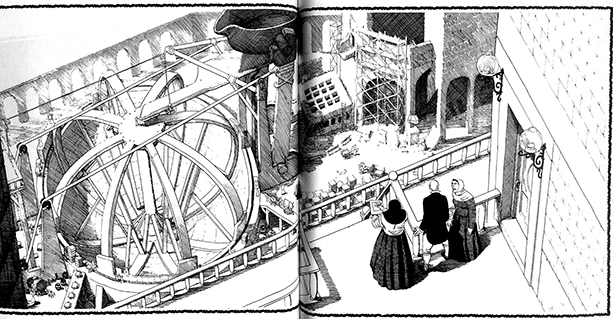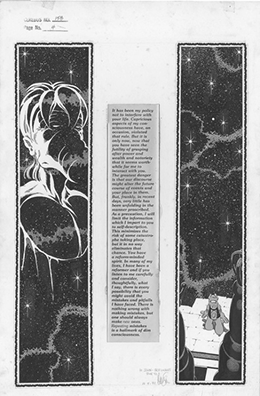Monthly Archives: March 2016
Cerebus re-read 2015–2016: Flight
 Boy, I’m not even sure where to begin with this one. It’s so dense, considering how short it is—I’ll try to keep the synopsis from spiraling out of control. I suppose the appropriate beginning point is to mention that this is the first volume in a four-part storyline called Mothers & Daughters, which Dave and Ger had been building up to very slowly since the first volume. Up until this point, the Cirinists have been mostly heard about and rarely seen, and these volumes go a long way into shedding some light on their inner workings and those of their rivals, the Kevillists (even less is known of them until now). Mothers & Daughters itself caps off the second third of Cerebus, and is very climactic in places, so we’re in for a wild ride.
Boy, I’m not even sure where to begin with this one. It’s so dense, considering how short it is—I’ll try to keep the synopsis from spiraling out of control. I suppose the appropriate beginning point is to mention that this is the first volume in a four-part storyline called Mothers & Daughters, which Dave and Ger had been building up to very slowly since the first volume. Up until this point, the Cirinists have been mostly heard about and rarely seen, and these volumes go a long way into shedding some light on their inner workings and those of their rivals, the Kevillists (even less is known of them until now). Mothers & Daughters itself caps off the second third of Cerebus, and is very climactic in places, so we’re in for a wild ride.
After slaughtering a couple Cirinists in a vengeful rage at the end of Melmoth, Cerebus books it into the heart of Iest’s lower city as he runs for his life. As a result of Cirinist’s ability to speak to one another telepathically, Cerebus is also fighting for his life, as droves of Cirinists descend upon him. Cirin (who we learned in Church & State is one of an indeterminate number of aardvarks in Estarcion) is telepathically alerted to these events by one of her generals, as she is busy purging the papal library of undesirable books and searching for any that may give her an advantage in taking part in her own Ascension. Cirin—believing Cerebus to be dead since he Ascended—is at first incredulous, but is at least partly convinced of his return by mental images of a dozen or so of her dead soldiers. As some Iestans witness the bloodshed from their homes and begin cheering on their former pope, Cerebus spots an opportunity. He climbs the side of a house and commands all Iestans to take back their city from the Cirinists by force. This is a stirring speech, and very effective, until the action begins. The Cirinists are a highly trained force and make very short work of the locals. Disobeying Cirin’s orders to take Cerebus alive (we’ll find out her motive in two more volumes), General Normina Swartzkof orders her archer to shoot Cerebus through the heart. At the last second, he disappears into thin air, the arrow flying through the window behind him. Cirin believes this to be the work of Suenteus Po, and orders any witnesses (barring mothers and children under five) to be executed in an effort to quell any further revolution.
 Meanwhile, the Roach, having lain dormant as “Normalroach” for the entirety of Melmoth, begins to feel that monumental changes are afoot. Estarcion itself feels these changes as well, as a number of characters from the first volume are returned to, and in most cases blinked out of existence as a result of Cerebus’ partial victory. This is the most explicit and powerful depiction of Cerebus’ “magnifier effect.” His unconscious ability to affect the world around him will be a major focus of Mothers & Daughters. The Roach changes himself into Punisherroach in order to align himself with Cerebus in a bid to defeat the Cirinists. He does this quite efficiently with his semi-automatic crossbows, and racks up a much higher body count than Cerebus did before he vanished. We find that Cerebus has returned to the Seventh Sphere, a sort of metaphysical environment that is shaped by one’s individual imagination, and a frequent hangout of Suenteus Po, noted Illusionist. Cerebus begins to fly upward, stating that he wants to see how far up it goes, for no other reason than curiosity and stubbornness. Though Po is particularly against this idea, Cerebus eventually breaks out of the Seventh Sphere and into the Eighth, which is pitch black in all directions, though “directions” is perhaps the wrong word, as Po tells Cerebus there are none here. However, as a manifestation of Cerebus’ psyche, the plane does allow for review of any point in one’s life. Po demonstrates this by making Cerebus relive the moments in his life in which he felt pure joy. Cerebus snaps out of it and decides to head upward again, reasoning with Po that he’s fed up with everyone around him trying to distract him. He sees a platform in the distance and despite the incredible physical pressure exerted upon him, makes his way over the top. There he finds an enormous chessboard and the translucent, imposing image of Suenteus Po, the third (of three) aardvarks in Estarcion.
Meanwhile, the Roach, having lain dormant as “Normalroach” for the entirety of Melmoth, begins to feel that monumental changes are afoot. Estarcion itself feels these changes as well, as a number of characters from the first volume are returned to, and in most cases blinked out of existence as a result of Cerebus’ partial victory. This is the most explicit and powerful depiction of Cerebus’ “magnifier effect.” His unconscious ability to affect the world around him will be a major focus of Mothers & Daughters. The Roach changes himself into Punisherroach in order to align himself with Cerebus in a bid to defeat the Cirinists. He does this quite efficiently with his semi-automatic crossbows, and racks up a much higher body count than Cerebus did before he vanished. We find that Cerebus has returned to the Seventh Sphere, a sort of metaphysical environment that is shaped by one’s individual imagination, and a frequent hangout of Suenteus Po, noted Illusionist. Cerebus begins to fly upward, stating that he wants to see how far up it goes, for no other reason than curiosity and stubbornness. Though Po is particularly against this idea, Cerebus eventually breaks out of the Seventh Sphere and into the Eighth, which is pitch black in all directions, though “directions” is perhaps the wrong word, as Po tells Cerebus there are none here. However, as a manifestation of Cerebus’ psyche, the plane does allow for review of any point in one’s life. Po demonstrates this by making Cerebus relive the moments in his life in which he felt pure joy. Cerebus snaps out of it and decides to head upward again, reasoning with Po that he’s fed up with everyone around him trying to distract him. He sees a platform in the distance and despite the incredible physical pressure exerted upon him, makes his way over the top. There he finds an enormous chessboard and the translucent, imposing image of Suenteus Po, the third (of three) aardvarks in Estarcion.
Po engages Cerebus in a game of chess. For every move Po makes, he tells Cerebus a little of his own history. For every move of Cerebus’, he is transported either physically or as an apparition to the locations of individuals from his past. We see King K’cor of Imesh, mad as a hatter as a result the loss of his beloved Sedra; Archbishop Posey in prison with Oscar (the Jaka’s Story one); and the enormous vision of a decayed Bran Mac Mufin. Po also relates to Cerebus his side of the trial in which Po was burned as a heretic—it was this that Cerebus saw in his vision before his Ascension. Po checkmates Cerebus and he is cast away from the chessboard.
Back in Estarcion, it seems everything is boiling. Punisherroach is taking out Cirinists left and right, the Pigts are marching toward Iest in order to take it back by force, and Cirin’s ascension continues to be stymied by inexplicable miscommunications and rotten luck. As a result, she orders Astoria to be temporarily released from prison and brought in to council Cirin on what she knows of Cerebus and his illusions. Astoria outlines conditions for this request, arguing that if Cirin is coming to her for help, she must be on considerably shaky ground. Eventually, Elrod shows up and attempts to get Punisherroach to accompany him to a brothel in order to let off some steam, which the Roach is not game for. He allows himself to be dragged along anyway—despite his striving for purity, he cannot quell his susceptibility to temptation. He is seen to by a prostitute named Blossom, who he promptly falls very much in love with, to Elrod’s alarm. Meanwhile, the evening before Astoria and Cirin’s meeting, they both see a vision of Cerebus re-entering their plane of existence.

Flight is great because it’s a terrific release after a couple years of very little Cerebus, less humor, and almost no action. The book is extremely frenetic, and it’s the most edge-of-one’s-seat action not only since the first volume, but in the whole series thus far. Dave’s paneling becomes a huge asset again as he’s able to push the action forward much more dynamically and fluidly than a lot of other artists at the time. His increasingly strong partnership with Gerhard also facilitates this, as it gives the characters something solid to work against, and a lot of depth to work within. It’s a very cathartic section of the story, and I often wonder if parallels can be drawn between the enthusiasm of Cerebus’ supporters and supporters of Cerebus at the time.
Another great detail of this volume is the reappearance of many of the interesting and varied antagonists from the first volume. Interspersed throughout the battle scenes, Dave’s well-paced vignettes centered on these characters definitely evoke a sense of things wrapping up or coming full circle—a theme of the entire Mothers & Daughters storyline. It’s a lot of fun to see Dave take a crack at drawing these characters again for the first time in a little over 10 years, especially Khem (referred to as a demon here, but as a succubus in issue #2), who was previously defined simply by the negative space around it. Here, Khem is given what seems to be more of a corporeal form, as Dave draws contours and textural details on it.
 There are two aspects of Flight that I find particularly important, and which become more so over the course of this storyline. One is certain revelations about Cerebus’ past that we learn through something other than casual conversation with Countess Michele. Po is able to tell Cerebus (and us) about very specific moments of his life from before the first volume in great detail, even down to the emotion he felt at the time. This is the most we’ve ever learned about who Cerebus really is, where he comes from, and what makes him tick. We’re going to get a lot more of that coming up. Secondly, we also learn a lot more about the Cirinists, particularly their telepathic ability. Dave represents this skill/power quite uniquely as floating diamond-shaped thought bubbles—white for regular conversation and black with white text for extreme emphasis. It’s the first visual we’ve seen that illustrates Bear’s comment on the Cirinist’s hive-mind, and goes a long way into explaining how they’ve been so successful in taking over Iest. We also get a look into the inner workings of the Cirinist government, with Cirin obviously on top, and her followers filling in various positions below her—subservient, yet generally not shy about speaking their mind as long as they hold a high enough position. Cirin is clearly not a ruthless dictator to the point of instantly killing anybody with an opposing opinion, at least where mothers are concerned. However, she will not tolerate detractors for too long, as we’ll see in the next volume, Women.
There are two aspects of Flight that I find particularly important, and which become more so over the course of this storyline. One is certain revelations about Cerebus’ past that we learn through something other than casual conversation with Countess Michele. Po is able to tell Cerebus (and us) about very specific moments of his life from before the first volume in great detail, even down to the emotion he felt at the time. This is the most we’ve ever learned about who Cerebus really is, where he comes from, and what makes him tick. We’re going to get a lot more of that coming up. Secondly, we also learn a lot more about the Cirinists, particularly their telepathic ability. Dave represents this skill/power quite uniquely as floating diamond-shaped thought bubbles—white for regular conversation and black with white text for extreme emphasis. It’s the first visual we’ve seen that illustrates Bear’s comment on the Cirinist’s hive-mind, and goes a long way into explaining how they’ve been so successful in taking over Iest. We also get a look into the inner workings of the Cirinist government, with Cirin obviously on top, and her followers filling in various positions below her—subservient, yet generally not shy about speaking their mind as long as they hold a high enough position. Cirin is clearly not a ruthless dictator to the point of instantly killing anybody with an opposing opinion, at least where mothers are concerned. However, she will not tolerate detractors for too long, as we’ll see in the next volume, Women.
Top Moments
The cover of issue #151. A perfectly framed, top Gerhard moment.
Death finding out from the Judge that he’s not actually Death and that he’s moments away from ceasing to exist.
Mrs. Copps’ conversation with Hammond in which he tries to explain to her that he can’t change the specifications of Cirin’s sphere mold without dismantling it and starting from scratch. You’d think Dave had some personal experience with this kind of client.
K’cor: “What is life like on the moon?”
Cerebus: “Like Imesh.”
K’cor: “eh?”
Cerebus: Empty…gray…except for one crazy old coot called The Judge…who talks about nothing but The Goddess all the time…”
Cirin’s conversation with her messenger about Astoria. The way that Dave implies timing in conversations makes Cerebus reads more naturally than any other comic I can think of.
Lord Julius’ confrontation with a would-be assassin in his bedchamber.

Recent Comments